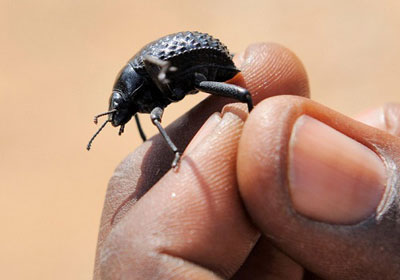| Posted: Jun 23, 2016 |
Saving precious water with nanoscale ingenuity
(Nanowerk News) Managing scarce water resources is problematic for many Middle East countries, and forecasts predict a more straitened situation ahead. Desalination plants are one way to manage water shortages, as more than two-thirds of the world’s desalination capacity is in this region, but processing seawater has enormous energy and environmental costs. Other approaches need to be developed to achieve sustainable growth.
|
|
Over the past seven years, Peng Wang and colleagues from the King Abdullah University of Science and Technology (KAUST) Biological and Environmental Science and Engineering Division, Saudi Arabia, have been looking for answers to these grand challenges by turning to very small science. The team specializes in producing materials and surfaces that purify, distill and catch water molecules with remarkable efficiency thanks to nanoscale techniques, many inspired by ingenious biological tricks.
|
 |
| The tiny bumps on the surface of the Stenocara beetle, a native of the Namib Desert, provided inspiration for water collection.
|
|
“It’s amazing what nature can offer us for solving some of the problems of clean water production,” said Wang. “This field really gives you a chance to demonstrate your most creative ideas.”
|
|
From beetle bumps to self-healing stills
|
|
Wang explains that he always approaches research with the concept of rational design in mind, which is using specific chemical and physical functions to achieve targeted results.
|
|
“You have to be able to define your problem scientifically first,” he said. “We then rationally decide on what functions to impart to the surfaces or materials. In some cases we mimic species to reach our goals.”
|
|
One such example was Wang’s search for a surface that collects atmospheric fog. The hunt led the researchers to the Stenocara beetle, a native of the Namib Desert. The beetle has special wings dotted with nanoscale bumps that capture water droplets from the air. The beetle’s waxy regions slide droplets directly into the its mouth.
|
|
To mimic the beetle's wings, the team used a different bio-inspired substance—an extra-sticky dopamine-based polymer similar to natural glues used by mussel shells—to stick bumpy patterns onto a super water-repellent surface through inkjet printing techniques.
|
|
Another of Wang’s projects revolves around developing point-of-use desalination devices powered by the sun. These solar stills could prove invaluable in the aftermath of natural disasters, but offer notoriously poor efficiency because it takes extended time to heat bulk quantities of water.
|
|
To solve this quandary, the research team coated a floating stainless steel membrane with an innovative polymer containing photo-sensitive rings. The new membrane absorbs light radiation instead of the bulk water and increases heat generation at the water surface.
|
|
The researchers also mimicked the lotus leaf flower, a plant that can repair damage to its leaves by tapping into a reservoir of waxy molecules, to heal any sun-based injuries to the membrane.
|
|
“This device tripled the output of fresh water compared to a typical solar still,” noted Wang.
|
|
Make one for the team
|
|
Wang reveals that open cooperation and communication between scientists, postdoctoral fellows and students in his bustling lab are the key to research success.
|
|
“You see lots of casual and regular meetings in a typical day,” he said. “We encourage members to share their knowledge, know-how, criticisms and concerns—this is how we work as a team.”
|
|
The state-of-the-art tools such as surface modification and water treatment available in Wang’s lab give researchers the chance to move into the elite ranks of scientific achievement. Since 2012, several of his papers on topics such as pH-responsive membranes that separate oil from water or nanomaterials that efficiently generate hydrogen from water have reached the top one percent of cited articles in their fields. Two of his edited books are also expected to appear in 2016.
|
|
“In our group, you need basic chemical synthesis skills, but I stress critical thinking more than anything else—you have to give defensible reasons for every step of your research,” said Wang. “Tackling relevant problems and mentoring brilliant young minds is what I find most rewarding.”
|
|
Being thin is in
|
|
The flow of water through commercial filtration membranes is limited by membrane thickness. Wang and his team are currently studying ways to accelerate this type of purification using ultrathin membranes made from stacks of graphene sheets. While the challenges of this project are intense and include making uniform pores on graphene with solution processing, the potential payoffs could be enormous.
|
|
“With generous funding and fantastic support, one can focus and do amazing things with our colleagues at the University’s Water Desalination and Reuse Center,” he said. “This is really not possible anywhere else.”
|

